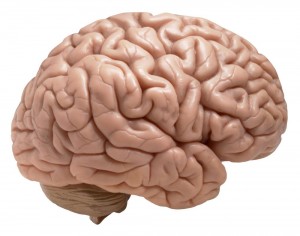Physical Attributes
These facts will teach you interesting bits of information about the physical make-up of the human brain.
1. Weight. The weight of the human brain is about 3 lbs.
2. Cerebrum. The cerebrum is the largest part of the brain and makes up 85% of the brain’s weight.
3. Skin. Your skin weighs twice as much as your brain.
4. Gray matter. The brain’s gray matter is made up of neurons, which gather and transmit signals.
5. White matter. The white matter is made up of dendrites and axons, which create the network by which neurons send their signals.
6. Gray and white. Your brain is 60% white matter and 40% gray matter.
7. Water. The brain is made up of about 75% water.
8. Neurons. Your brain consists of about 100 billion neurons.
9. Synapses. There are anywhere from 1,000 to 10,000 synapses for each neuron.
10. No pain. There are no pain receptors in the brain, so the brain can feel no pain.
11. Largest brain. While an elephant’s brain is physically larger than a human brain, the human brain is 2% of total body weight
(compared to 0.15% of an elephant’s brain), meaning humans have the largest brain to body size.
12. Blood vessels. There are 100,000 miles of blood vessels in the brain.
13. Fat. The human brain is the fattest organ in the body and may consists of at least 60% fat.
The Developing Brain
Starting from within the womb, fetal brain development begins the amazing journey that leads to a well-developed brain at birth that continues to grow for 18 more years.
14 Neurons. Neurons develop at the rate of 250,000 neurons per minute during early pregnancy.
15. Size at birth. At birth, your brain was almost the same size as an adult brain and contained most of the brain cells for your whole life.
16. Newborn’s growth. A newborn baby’s brain grows about three times its size in the first year.
17. Stopped growing. Your brain stopped growing at age 18.
18. Cerebral cortex. The cerebral cortex grows thicker as you learn to use it.
19. Stimulation. A stimulating environment for a child can make the difference between a 25% greater ability to learn or 25% less in
an environment with little stimulation.
20. New neurons. Humans continue to make new neurons throughout life in response to mental activity.
21. Read aloud. Reading aloud and talking often to a young child promotes brain development.
22. Emotions. The capacity for such emotions as joy, happiness, fear, and shyness are already developed at birth. The specific type
of nurturing a child receives shapes how these emotions are developed.
23. First sense. The first sense to develop while in utero is the sense of touch. The lips and cheeks can experience touch at about 8
weeks and the rest of the body around 12 weeks.
24. Bilingual brains. Children who learn two languages before the age of five alters the brain structure and adults have a much denser
gray matter.
25. Child abuse and the brain. Studies have shown that child abuse can inhibit development of the brain and can permanently affect
brain development.
Brain Function
From the invisible workings of the brain to more visible responses such as yawns or intelligence, find out how the brain functions with these facts.
26. Oxygen. Your brain uses 20% of the total oxygen in your body.
27. Blood. As with oxygen, your brain uses 20% of the blood circulating in your body.
28. Unconsciousness. If your brain loses blood for 8 to 10 seconds, you will lose consciousness.
29. Speed. Information can be processed as slowly as 0.5 meters/sec or as fast as 120 meters/sec (about 268 miles/hr).
30. Wattage. While awake, your brain generates between 10 and 23 watts of power–or enough energy to power a light bulb.
31. Yawns. It is thought that a yawn works to send more oxygen to the brain, therefore working to cool it down and wake it up.
32. Neocortex. The neocortex makes up about 76% of the human brain and is responsible for language and consciousness. The
human neocortex is much larger than in animals.
33. 10%. The old adage of humans only using 10% of their brain is not true. Every part of the brain has a known function.
34. Brain death. The brain can live for 4 to 6 minutes without oxygen, and then it begins to die. No oxygen for 5 to 10 minutes will result
in permanent brain damage.
35. Highest temperature. The next time you get a fever, keep in mind that the highest human body temperature ever recorded was
115.7 degrees–and the man survived.
36. Stress. Excessive stress has shown to “alter brain cells, brain structure and brain function.”
37. Love hormones and autism. Oxytocin, one of the hormones responsible for triggering feelings of love in the brain, has shown
some benefits to helping control repetitive behaviors in those with autism.
38. Food and intelligence. A study of one million students in New York showed that students who ate lunches that did not include
artificial flavors, preservatives, and dyes did 14% better on IQ tests than students who ate lunches with these additives.
39. Seafood. In the March 2003 edition of Discover magazine, a report describes how people in a 7-year study who ate seafood at least
one time every week had a 30% lower occurrence of dementia.
Psychology of the Brain
From tickling to tasting to decision-making, find out how the brain affects what you experience.
40. Tickles. You can’t tickle yourself because your brain distinguished between unexpected external touch and your own touch.
41. Imaginary playmates. A study from Australia showed that children with imaginary playmates between the ages of 3 and 9 tended to
be first-born children.
42. Reading faces. Without any words, you may be able to determine if someone is in a good mood, is feeling sad, or is angry just by
reading the face. A small area in the brain called the amygdala is responsible for your ability to read someone else’s face for clues to
how they are feeling.
43. Ringing in the ears. For years, medical professionals believed that tinnitus was due to a function within the mechanics of the ear,
but newer evidence shows that it is actually a function of the brain.
44. Pain and gender. Scientists have discovered that men and women’s brains react differently to pain, which explains why they
may perceive or discuss pain differently.
45. Supertasters. There is a class of people known as supertasters who not only have more taste buds on the tongue, but whose brain
is more sensitive to the tastes of foods and drinks. In fact, they can detect some flavors that others cannot.
46. Cold. Some people are much more sensitive to cold and actually feel pain associated with cold. Research as shown that the reason
is due to certain channels that send cold information to the brain.
47. Decision-making. Women tend to take longer to make a decision, but are more likely to stick with the decision, compared to men,
who are more likely to change their mind after making a decision.
48. Exercise. Some studies indicate that while some people are naturally more active, others are naturally more inactive, which may
explain why getting out and exercising is more difficult for some.
49. Boredom. Boredom is brought on by a lack of change of stimulation, is largely a function of perception, and is connected to the
innate curiosity found in humans.
50. Physical illness. The connection between body and mind is a strong one. One estimate is that between 50-70% of visits to the
doctor for physical ailments are attributed to psychological factors.
51. Sadness and shopping. Researchers have discovered that those experiencing the blues are more willing to spend more money in
an attempt to alleviate their sadness.
Memory
Learn how scent, jet lag, and estrogen affect memory, plus plenty of other information, with these facts.
52. Jet lag. Frequent jet lag can impair your memory, probably due to the stress hormones released.
53. New connections. Every time you recall a memory or have a new thought, you are creating a new connection in your brain.
54. Create associations. Memory is formed by associations, so if you want help remembering things, create associations for yourself.
55. Scent and memory. Memories triggered by scent have a stronger emotional connection, therefore appear more intense than
other memory triggers.
56. Anomia. Anomia is the technical word for tip-of-the-tongue syndrome when you can almost remember a word, but it just won’t
quite come to you.
57. Sleep. While you sleep at night may be the best time for your brain to consolidate all your memories from the day.
58. No sleep. It goes to follow…lack of sleep may actuallyhurt your ability to create new memories.
59. World Champion. A world champion memorizer, Ben Pridmore memorized 96 historical events in 5 minutes and memorized a single,
shuffled deck of cards in 26.28 seconds.
60. Estrogen and memory. Estrogen (found in both men and women) has been shown to promote better memory functions.
61. Insulin. Insulin works to regulate blood-sugar in the body, but recently, scientists have discovered that its presence in the brain
also helps promote memory.
Dreams and Sleep
The amazing world of dreams and what happens during sleep is a mystery rooted in the brain. Learn interesting facts about dreams and sleep in this list.
62. Everyone dreams. Just because you don’t remember your dreams doesn’t mean you don’t dream. Everyone dreams!
63. Nightly average. Most people dream about 1-2 hours a night and have an average of 4-7 dreams each night.
64. Brain waves. Studies show that brain waves are more active while dreaming than when you are awake.
65. Lost dreams. Five minutes after a dream, half of the dream is forgotten. Ten minutes after a dream, over 90% is forgotten. Write
down your dreams immediately if you want to remember them.
66. Blind people dream. Dreams are more than just visual images, and blind people do dream. Whether or not they dream in pictures
depends on if they were born blind or lost their vision later.
67. Color or B&W. Some people (about 12%) dream only in black and white while others dream in color.
68. Virtually paralyzed. While you sleep, your body produces a hormone that may prevent you from acting out your dreams, leaving
you virtually paralyzed.
69. Snoring. If you are snoring, you are not dreaming.
70. During a dream. If you are awakened during a dream, you are much more likely to remember the dream than if you slept until a full
night’s sleep.
71. Symbolism. As those who invest in dream dictionaries can attest, dreams almost never represent what they actually are.
The unconscious mind strives to make connections with concepts you will understand, so dreams are largely symbolic representations.
72. Adenosine. Caffeine works to block naturally occurring adenosine in the body, creating alertness. Scientists have recently discovered
this connection and learned that doing the opposite–boosting adenosine–can actually help promote more natural sleep patterns and
help eliminate insomnia.
73. Dream showings. Japanese researchers have successfully developed a technology that can put thoughts on a screen and may soon
be able to screen people’s dreams.
Fun and Interesting Facts
From juggling to a Brain Bank to cannibalism, read about these fun and interesting brain facts.
74. Airplanes and headaches. A study showed a correlation between flying and headaches and states that around 6% of people who fly
get headaches brought on by the flight itself.
75. Juggling. Juggling has shown to change the brain in as little as seven days. The study indicates that learning new things helps the
brain to change very quickly.
76. Disney and sleep. A study published in the journal Sleep Medicine describes how Disney creators used real sleep disorders in many
of their animated pets.
77. Blinking. Each time we blink, our brain kicks in and keeps things illuminated so the whole world doesn’t go dark each time we blink
(about 20,000 times a day).
78. Laughing. Laughing at a joke is no simple task as it requires activity in five different areas of the brain.
79. Yawns are contagious. Ever notice that you yawned after someone around you did? Scientists believe this may be a response to
an ancient social behavior for communication that humans still have.
80. Brain Bank. Harvard maintains a Brain Bank where over 7,000 human brains are store for research purposes.
81. Outer space. The lack of gravity in outer space affects the brain in several ways. Scientists are studying how and why, but you
may want to hold off on your next trip to the moon.
82. Music. Music lessons have shown to considerably boost brain organization and ability in both children and adults.
83. Thoughts. The average number of thoughts that humans are believed to experience each day is 70,000.
84. Ambidexterity. Those who are left-handed or ambidextrous have a corpus collosum (the part of the brain that bridges the two
halves) that is about 11% larger than those who are right-handed.
85. Stressful job. According to a study by Bristol-Myers Squibb, accountants have the highest incidence of on-the-job headaches,
followed by librarians, then bus and truck drivers.
86. Aristotle. Aristotle mistakenly thought that the functions of the brain actually took place in the heart.
87. Cannibalism. Some research shows that humans carry genes that help protect the brain from prion diseases, or diseases
contracted through eating human flesh, leading medical experts to believe that ancient humans may have eaten other humans.
88. Shakespeare. The word “brain” appears 66 times in the plays of William Shakespeare.
Famous Brains
People have always been fascinated with the brains of famous people. Find out what experts know about these famous brains.
89. Albert Einstein. Einstein’s brain was similar in size to other humans except in the region that is responsible for math and
spatial perception. In that region, his brain was 35% wider than average.
90. London taxi drivers. Famous for knowing all the London streets by heart, these drivers have a larger than normal hippocampus,
especially the drivers who have been on the job longest. The study suggests that as people memorize more and more information,
this part of their brain continues to grow.
91. VI Lenin. After his death, Lenin’s brain was studied and found to have an abnormally large and numerous neurons in a particular
region that may explain his “strikingly acute and penetrating mental processes” for which he was famous.
92. Oldest brain. A brain thought to be 2000 years old was unearthed just recently at the University of York in northern England.
93. Babe Ruth. The Babe was tested by two Columbia psychology students and was determined to be working at 90% efficiency
compared to the 60% efficiency measured for most people.
94. Daniel Tammet. Daniel Tammet is an autistic savant who, since the age of three when he suffered an epileptic seizure, has been able
to perform astounding mathematical computations, knows seven languages, and is developing a language of his own.
95. Keith Jarrett. This jazz musician was discovered at age 3 to have perfect pitch, which scientists can pinpoint in the right frontal lobe.
Moments in History
The study of the brain has an interesting history. Check out this abbreviated time line to learn interesting facts about the history of brain research and development.
96. 2000 B.C.. Archeologists found evidence that primitive brain surgery was performed by drilling a hole in the skull.
97. 1811. Scottish surgeon Charles Bell described how each of the senses had a corresponding spot in the brain.
98. 1899. Aspirin was marketed as a pain reliever, but was not available without a prescription until 1915.
99. 1921. Hermann Rorschach invented the now-famous ink blot test for use with his patients.
100. 1959. The first rhesus monkey was sent into space to study human behavior.






Schools9 Final results MANABADI Inter very first Year Provide Results 2013 Andhra Pradesh
Intermediate primary Year Professional Superior Additional 2013 Final results Access from Manabadi.com
Appreciate the recommendatiοn. Will try it out.
It’s going to be finish of mine day, but before end I am reading this
enormous article to increase my know-how.
It’s nearly impossible to find educated people about this subject, but you seem like you know what you’re
talking about! Thanks